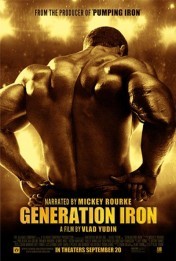A new docudrama covers the subculture of bodybuilding
Myths abound about the subculture of bodybuilding, a sport that took off with the explosion of the health-and-fitness industry in the 1970s.
Back then, the public knew even less about these extreme and dedicated athletes until the release of a breakthrough docudrama in 1977, “Pumping Iron,” produced by Jerome Gary and featuring a champion named Arnold Schwarzenegger.
The film has long fascinated Vlad Yudin (vladar.com). Last Friday, his documentary “Generation Iron,” created with “Pumping Iron” producer Gary and narrated by Mickey Rourke, was released.
Yudin spent months with the seven bodybuilders featured in the docudrama as they prepared for the Mr. Olympiad contest. He says he came away with an appreciation of how little the public still knows about the sport and the athletes who so compulsively pursue physical perfection. For one, many people believe bodybuilding is about size – not true.
“It’s about developing symmetry,” he says.
Here are four myths he says are rampant in literature about bodybuilders, and why they’re not true.
• Myth No. 1: Bodybuilders suffer from “negative body image,” or “reverse anorexia.” Many observers have written that bodybuilders are driven by an eating disorder known as reverse anorexia: No matter how big they get, when they look in the mirror, they still see a skinny wimp. Not true, says Yudin. “The whole point of this sport is to perfect the physique – the goal is to develop perfect symmetry, not to get as big as you can be. These guys are striving for a perfect score in competition. If they see a weak spot, they’re going to work on building that up.”
• Myth No. 2: Bodybuilders depend on steroids to achieve results. Steroids do not make champions, Yudin says. Bodybuilding champs are athletes so dedicated to constantly consuming the right nutrients on the right schedule and to working out, it becomes a lifestyle. “People think they’re just pumping themselves up with steroids, but bodybuilding is a science that requires effort 100 percent of the time, Yudin says.
• Myth No. 3: Bodybuilders have low self-esteem. For some, this may have been true at one point in their lives, Yudin says. Some experienced bullying; others had acceptance issues. But most now have a healthy, even robust, sense of self-esteem. “You can see it in how they carry themselves. They don’t do this because of a lack of confidence,” he says. “If they did, they wouldn’t be able to go on stage and be judged with such intense scrutiny on their physique. They’ve put in a lot of work and they know they look good.” He gives the example of Phil Heath, one of the seven men featured in his film. Heath grew up as a talented athlete and played basketball for the University of Denver. “He started hitting the gym more to train, and became more interested in bodybuilding than basketball,” Yudin says. The two-time Mr. Olympia knew he had talent from the get-go and took advantage of it, he says.
• Myth No. 4: Body builders are socially isolated. They get a rap because they dedicate their life to the gym and their diet, Yudin says. They eat every two to three hours and they’re in the gym two to three times a day. You just don’t see them out and about very often. “But four of the seven men we featured are married. A fifth lives with the mother of his children, and a sixth got married after we stopped shooting. Their family lives are a big part of the film,” Yudin says. While he concedes bodybuilders have to be selfish to a degree in order to maintain their grueling schedule, that doesn’t mean they’re loners who avoid others.
“Branch Warren is a devoted family man who brings his daughter to competitions,” Yudin says. “In the film, you see him carrying his daughter through the back stage.”

